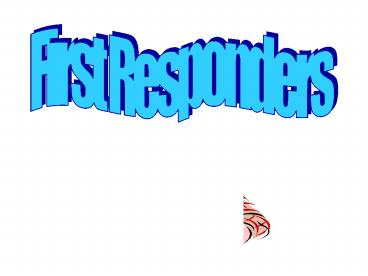First Responders - PowerPoint PPT Presentation
1 / 37
Title:
First Responders
Description:
First Responders at the Awareness Level are expected ... Placards. Communicate. It is imperative to communicate information gathered during approach and initial ... – PowerPoint PPT presentation
Number of Views:63
Avg rating:3.0/5.0
Title: First Responders
1
First Responders
2
What is an "EVENT"?
3
(No Transcript)
4
Commons and Typicals
- Petroleum product releases
- Usually occur in fixed facilities
- Abandonment or intentional
- Typical exposure is inhalation
- Typical problem is
Poor response management
5
What is your role?
6
(No Transcript)
7
(No Transcript)
8
First Responders at the Awareness Level are
expected to recognize the presence of hazardous
materials, protect themselves appropriately, call
for help, and secure the area.
9
(No Transcript)
10
(No Transcript)
11
Approach
- Upwind
- Uphill
- Upstream
12
Hands Off!
- Until the nature of the incident is clearly
determined. - Personal Protection is Ensured.
13
Identify
- Vapor clouds
- Smoke
- Injured persons
- Surrounding populations
- Dispersion pathways
- Environmental damage
14
Always think of Multiple hazards
15
Look for Labels Signs Placards
16
Communicate
- It is imperative to communicate information
gathered during approach and initial scene survey
to the dispatcher to ensure actions are taken.
17
Provide as much information as can be gathered
- Chemical names
- Chemical numbers
- Site conditions
- Leaks, fires, fumes
- Describe involved area
- Are there victims
18
Secure the area
- Direct all non-essential personnel and general
public away from the area. - Establish a secure zone around the incident scene
and set-up an access point. - Use warning sirens if necessary
19
Brief Incident Commander of scene accessment and
all actions taken
20
Know Your Limits. Respond Accordingly
21
Hazardous Materials Recognition and Safety
22
S.I.N.
- Safety
- Isolation
- Notification
23
First Operational Thought -
- Safety
- -first
- -last
- -always
24
The DOs of Safety
- think safety and consider it a big deal!!!
- notify and request assistance early
- report your location
- evacuate and warn public early
- stay uphill, upgrade and upwind
- recognize your limits
- weigh risk against benefits
- remember possibility of multiple hazards
- isolate and deny entry
- communicate and coordinate
- ensure the safety of all on-scene personnel
25
The DO NOTs of Safety
- DONT be overly aggressive
- DONT touch, breath or swallow it
- DONT act without a plan
- DONT act on emotion
- DONT confuse rescue with evacuation
- DONT key in on one hazard
- DONT take victims to the incident
- DONT let small amounts fool you
- DONT be lulled into a false sense of security
- DONT lose sight of your mission
- DONT get coaxed into a bad situation
- DONT have a negative safety attitude
26
First Operational Priority
- Isolate
- Deny Entry
27
Isolation and Deny EntryObjectives
- Control all entry points
- Control Area around Hazard
- Control Access Inside Perimeter
28
Awareness vs. Operations
- Awareness
- - witness or discover a release
- - initiate and emergency response
- - notify the authorities of the release
- Operations
- - respond in a defensive fashion
- - protect persons, property environment
- - contain the release from a safe distance
29
The Incident Command System (ICS)
- Is a customized, standardized response tool that
meets the jurisdictional needs, resources and
realities of an incident. It must be used in a
response. - First Responders at the Awareness Level should
be familiar with some basic ICS operations.
30
ICS (Cont.)
- Incident Commander (boss)
- First responder
- Campus Police
- Fire Department
- HAZMAT
- Orange County Health
31
ICS (Cont.)
- Other Command Functions
- Safety Officer
- Public Information Officer
- Other Support Personnel
32
ICS (Cont.)
- Other Support Functions
- Operations (doers)
- Logistics (getters)
- Planning Intelligence (thinkers)
- Finance Administration (payers)
33
IdentificationHazard Assessment (IDHA)
- Our Goal To protect life, property and the
environment.
34
IDHA (Cont.)
- Identification and Hazard Assessment can be a
complex long process. - 1) Identify the material.
- 2) Assess all hazards the substance presents.
- 3) Assess physical chemical properties.
- 4) Assess variables and modifiers.
- 5) Assess behavior and outcomes.
35
The Action Plan
- Required for all Hazmat events.
- Identifies the Problem.
- Identifies the Resources.
- Think/Plan before you act!
36
(No Transcript)
37
(No Transcript)
38
(No Transcript)
39
(No Transcript)
40
Fitting this all Together
- Know your limitations
- Make a positive difference
- Be a part of the solution Not part of the
problem! - and dont forget































